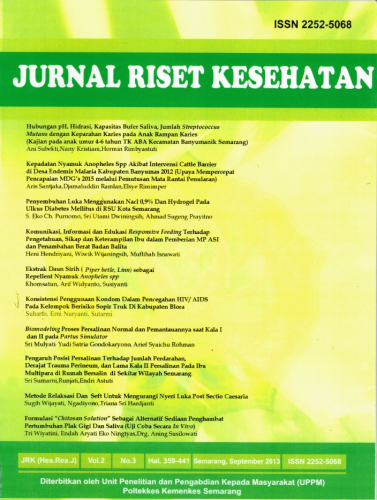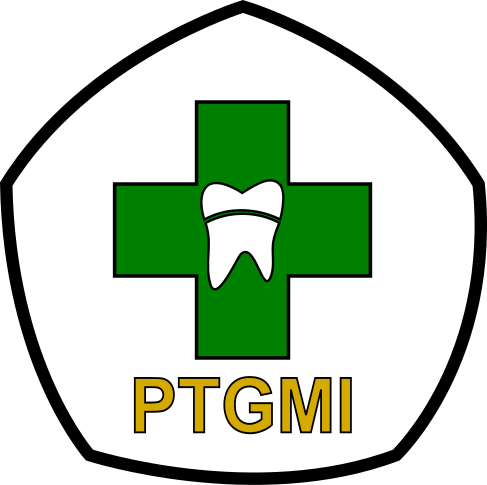THE EFFECT OF KAFFIR LIME (CITRUS HYSTRIX) ESSENTIAL OIL ON BEHAVIOR AND MORTALITY OF Aedes aegypti LARVAE
Abstract
DHF vector control still uses chemicals. Long-term application can lead to target insect resistance and environmental pollution so that a better alternative is to use biological insecticides because it is environmentally friendly. The aim of the study is to identify the effect of kaffir lime peel essential oil on the behavior and mortality of Ae.aegypti larvae. The research method used was completely randomized design of three treatments and three replications. The results show that larval behavior after administration of kaffir lime peel essential oil at a concentration of 103 ppm decreased the frequency of movement, the larvae were unable to rise to the surface of the water after 1.5 hours. The results of the research were tested with probit analysis at a confidence level of 95% LD 263,552 ppm. The analysis result in one-way ANOVA for the number of differences in the number of dead larvaes, with the value obtained sig. = 0.000, which means that there is a significant influence on differences in doses of papaya seeds powder solution used against the death of Ae. aegypti larvaes. Kaffir lime peel contains essential oils that can be used as biological insecticides in DHF vector control.
Keywords
Full Text:
PDFReferences
Adrianto, H., Yotopranoto, S., & Hamidah. (2014). Efektivitas Ekstrak Daun Jeruk Purut (Citrus hystrix), Jeruk Limau (Citrus amblycarpa), dan Jeruk Bali (Citrus maxima) terhadap Larva Aedes aegypti. Aspirator, 6(1), 1–6.
Ahbirami, R., Zuharah, W. F., Thiagaletchumi, M., Subramaniam, S., & Sundarasekar, J. (2014). Larvicidal efficacy of different plant parts of railway creeper, ipomoea cairica extract against dengue vector mosquitoes, aedes albopictus (Diptera: Culicidae) and aedes aegypti (Diptera: Culicidae). Journal of Insect Science, 14(Isman 2006). https://doi.org/10.1093/jisesa/ieu042
Araujo, A., Joao, T., Juliana, T., Socrates, C., Rogeria, D., Pericles, B., & Et, A. (2016). Larvicidal Activity of Syzygium aromaticum (L.) Merr and Citrus sinensis (L.) Osbeck Essential Oils and their Antagonistic Effects with Temephos in Resistant Populations of Aedes aegypti. Memorias Do Instituto Oswaldo Cruz, 111(7), 443–449. https://doi.org/10.1590/0074-02760160075
Bedini, S., Flamini, G., Cosci, F., Ascrizzi, R., Benelli, G., & Conti, B. (2016). Cannabis sativa and Humulus lupulus essential oils as novel control tools against the invasive mosquito Aedes albopictus and fresh water snail Physella acuta. Industrial Crops and Products, 85, 318–323. https://doi.org/10.1016/j.indcrop.2016.03.008
Botas, G., Rodrigo, A., Fernanda, B., Jonatas, L., Raquel, S., Raimundo, N., & Et, A. (2017). Baccharis reticularia DC. and Limonene Nanoemulsions: Promising Larvicidal Agents for Aedes aegypti (Diptera: Culicidae) Control. Molecules, 22, 1–14. https://doi.org/10.3390/molecules22111990
Dias, FC CN and Denise, F. (2014). Essential oils and their compounds as Aedes aegypti L. (Diptera: Culicidae) larvicides: Review. Parasitology Research. https://doi.org/10.1007/s00436-013-3687-6
Fujiwaraa, G., Vinicius, A., Camila, F., Ricardo, A., Maria, M., Fernando, C., & Et, A. (2017). Ecotoxicology and Environmental Safety Ecotoxicology and Environmental Safety. Ecotoxicology and Environmental Safety, 139(2017), 238–244. https://doi.org/x.doi.org/10.1016/j.ecoenv.2017.01.046
Gnankiné, O., & Imaël, H. (2017). Essential Oils as an Alternative to Pyrethroids ’ Resistance against Anopheles Species Complex Giles. Molecules, 22, 1–23. https://doi.org/10.3390/molecules22101321
Hamidah., & Hebert, A. (2017). Toxicity of Citrus mitis, Citrus aurantifolia, and Citrus maxima Leaf Extract Toward Mortality of Aedes aegypti Larvae ( Diptera : Culicidae ). The Veterinary Medicine International Conference, 41–47. https://doi.org/10.18502/kls.v3i6.1105
Ihemanma, C., Adindu, R., Kalu, M., & Kalu, E. (2014). Laboratory evaluation of ethanolic extracts of citrus sinensis peels and piper guineense (seeds and leaves) on mosquito larvae. Journal of Environment and Human, 1(1), 19–24.
Kelkenberg, M., Odman-Naresh, J., Muthukrishnan, S., & Merzendorfer, H. (2015). Chitin is a necessary component to maintain the barrier function of the peritrophic matrix in the insect midgut. Insect Biochemistry and Molecular Biology, 56, 21–28. https://doi.org/10.1016/j.ibmb.2014.11.005
Kementerian Kesehatan RI. (2016a). Infodatin : Pusat Data dan Informasi Kementerian Kesehatan RI. Jakarta.
Kementerian Kesehatan RI. (2016b). Profil Kesehatan Indonesia Tahun 2015. (D. Budijanto, Yudianto., H. Boga, & A. Titi, Eds.). Jakarta: Kementerian Kesehatan RI.
Kementerian Kesehatan RI. (2017). Data dan Informasi Profil Kesehatan Indonesia Tahun 2016. (H. Boga, Yudianto., & S. Tit, Eds.). Jakarta.
Mallick, S., Banerjee, R., & Chandra, G. (2015). Mosquito larvicidal potential of ethanol leaf extract of the plant, Annona reticulata L. against Aedes aegypti L. and Culex quinquefasciatus Say (Diptera: Culicidae). Journal of Mosquito Research, 5(19), 1–7. https://doi.org/10.5376/jmr.2015.05.0019
Monika N, R. W., & Waikabubak. (2016). Larvasida Hayati Yang Digunakan Dalam Upaya Pengendalian Vektor Penyakit Demam Berdarah di Indonesia. SEL, 3(1), 31–40.
Mya, M. M., Aye, Y. Y., Oo, A. W., & Saxena, R. K. (2015). Effect of Citrus hystrix DC Leaves Ethanol Extract on Larvae of Aedes aegypti. Journal of Biological Engineering Research and Review, 2(2), 1–6. Retrieved from www.biologicalengineering.in/Archive
Nirma, Andi, S., Hasbi, I., & Munawir, A. (2015). Efektivitas Larvasida Ekstrak Kulit Buah Jeruk Nipis ( Citrus aurantifolia ) Dalam Membunuh Jentik Nyamuk Aedes sp ( Studi di Daerah Epidemi DBD di Wilayah Kerja. Higiene, 1(2), 2017.
Nisa K, Firdaus, Ovi F, Ahmadi, H. (2015). Uji Efektifitas Ekstrak Biji dan Daun Mengkudu (Morinda Citrifolia L.) sebagai Larvasida Aedes sp. Badan Penelitian Dan Pengembangan Kesehatan, 2(2), 44. Retrieved from http://ejournal.litbang.depkes.go.id/index.php/sel/article/download/4636/4142
Pierre, S., EC Okechukwu, Y Lame, N. N. (2014). Larvicidal and Pupicidal Toxicities of Plectranthus glandulosus and Callistemon rigidus Leaf Essential Oils against Three Mosquito Species. Journal of Mosquito Research, 4(2), 5–14. https://doi.org/10.5376/jmr.2014.04.0002
Pinto CC, Jane ESAM, Sônia MC, Diego SMS, Cleia RS, H. S. (2016). Chemical composition and larvicidal activity against Aedes aegypti of essential oils from Croton zehntneri. Boletín
Latinoamericano y Del Caribe de Plantas Medicinales y Aromáticas, 15(2), 122–127. https://doi.org/10.3390/molecules15085734
Poolprasert, P., Pama, W., Chammui, Y., & Thongchai, W. (2015). Screening of Medical Plants Extracts for Larvicidal Activity against Culex quinquefasciatus ( Diptera : Culicidae ). The International Conference on Herbal and Traditional Medicine, (Htm), 228–230.
RAJ, G. A., Chandrasekaran, M., Venkatesalu, V., & Jegan, S. (2017). Phytochemical Composition and Larvicidal Activity of Essential Oil from The Leaves of Pleitospermium alatum ALATUM ( WALL . EX WT . & ARN ) Swingle Against Aedes aegypti, Anpheles stephensi and Culex quinquefasciatus (Dptera : Culicidae), 4(5), 5–8.
Rocha, D., Olivia, M., Maria, T., Ana, C., Manuel, D., & Chtistina, M. (2015). Larvicidal Activity against Aedes aegypti of Foeniculum vulgare Essential Oils from Portugal and Cape Verde. Natural Product Communications, 10(4), 677–682. https://doi.org/10.1073/pnas.0703993104
Santos, L., Jessica, S., Mirela, A., Nadja, B., Patricia, C., Suyana, K., & Et, A. (2017). Fatty acid-rich volatile oil from Syagrus coronata seeds has larvicidal and oviposition-deterrent activities against Aedes aegypti. Physiological and Molecular Plant Pathology, 100, 35–40. https://doi.org/10.1016/j.pmpp.2017.05.008
Sihombing, J. R., Dharma, A., Chaidir, Z., Almahdy, Fachrial, E., & Munaf, E. (2015). Phytochemical screening and antioxidant activities of 31 fruit peel extract from Sumatera, Indonesia. Journal of Chemical and Pharmaceutical Research, 7(11).
Sneha, A., & Preet, S. (2016). Impact of Sublethal Conventional and Biorational Larvicidal Stress on Fitness Status in Nutritionally Challenged Aedes aegypti Larvae. International Journal of Mosquito Research, 3(1), 39–46.
Soonwera, M. *. (2015). Efficacy of Essential Oils from Citrus plants against Mosquito vectors Aedes aegypti (Linn.) and Culex quinquefasciatus (Say). Internatioal Journal of Agricultural Technology, 11(3), 669–681. Retrieved from http://www.ijat-aatsea.com
Sulistiyani, A. (2015). Effectiveness of Essential Oil as Larvacide on Aedes aegypti. Jurnal Majority, 4(3), 22–28.
Torres, S., Nadine, L., Vitor, P., Maria, I., Leucio, C., & Valdemiro, A. (2014). Cumulative Mortality of Aedes aegypti Larvae Treated with Compounds. Rev Saúde Pública, 48(3), 445–450. https://doi.org/10.1590/S0034-8910.2014048005022
WHO. (2005). Guidelines for laboratory and field testing of mosquito larvicides. World Health Organization. https://doi.org/Ref: WHO/CDS/WHOPES/GCDPP/2005.11
Yu, K., Wong, C., Ahmad, R., & Jantan, I. (2015). Larvicidal activity, inhibition effect on development, histopathological alteration and morphological aberation induced by seaweed extracts in Aedes aegypti (Diptera: Culicidae). Asian Pacific Journal of Tropical Medicine, 8(12), 1006–1012. https://doi.org/10.1016/j.apjtm.2015.11.011
Yuliasih, Y., & Mutiara, W. (2017). Aktivitas Larvasida Berbagai Pelarut pada Ekstrak Biji Kayu Besi Pantai ( Pongamia pinnata ) terhadap Mortalitas Larva Aedes spp . Larvicidal Activity of Various Solvents of Pongamia pinnata Seed Extract on the Mortality of Aedes spp . Balaba, 13(2), 125–132. https://doi.org/https://doi.org/10.22435/blb.V13i2.5807.125-132
DOI: https://doi.org/10.31983/jrk.v9i1.4953
Article Metrics
Refbacks
- There are currently no refbacks.
Copyright (c) 2020 Jurnal Riset Kesehatan




















































